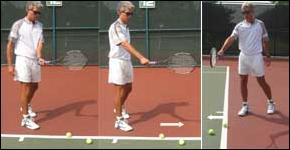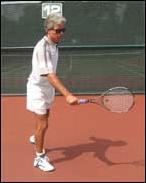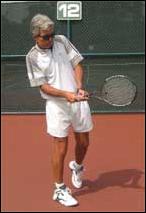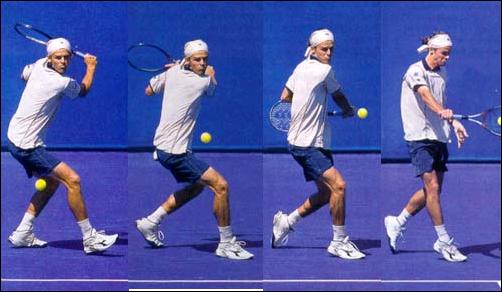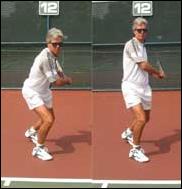Revolutionary Tennis |
||
Tennis Instruction That Makes Sense |
||
Part II: How To Help Your Backhand Groundstroke
A) IF you improve your rhythm by improving your locomotion pattern, AND improve your timing by improving both your vision and balance techniques, You'll hit the ball with more power, but you'll lose control. B) TO improve your (stroke's) control, Your grip needs to be firm AND the arm(s) needs to be relaxed during the forward swing. This means the arm(s) bends and unbends, or folds/unfolds, during the back/forward swing. You also can't overswing or overdo or use techniques which try to compensate for the body being incorrectly structured, which means no straight-arm, extend-an-arm, Inspector Gadget-arm, or pendulum bowling-arm here. C) THE final piece of the puzzle is: FOLLOW THE YELLOW BRICK ROAD Trust yourself. First. You know you can do it on a forehand, but there's doubt on the backhand. When your body works in just-the-same-way on the backhand as on the forehand you'll sing, "Bye, bad-backhand." Strong backhands, as forehands, are based on the universality of how the body moves and structures itself for power (as outlined by Revolutionary Tennis) married with tennis' reality of a ball angling away from you. So much for the good news. Now for the bad news. . This new backhand of yours is going to take some time to wrap your arms around. At first it's gonna feel awkward, moving unlike you're used to, balancing unlike you're used to, watching the ball differently, trusting the whole thing and yourself. Why awkward? Because you're no longer compensating or being lazy, sort of like learning to walk or stand with proper posture How much time? I don't know. Generally speaking, if you play twice a week it will take you - I'm guessing - 6 months. But then that's all related to the level of your input, and how well you're willing to take two steps back before catapulting forward. It may take you less time, it may take you more. Who knows. Does it matter? Not really. It's the process that counts, knowing you are on your way. There are four natural weaknesses with both one and two handed backhands. These are: 1. Footwork. See Step2 . You cross over step first (arrhythmic when planning to hit off the front foot). The angle of approach is too much to the side fence (momentum not headed into the ball/supporting the stroke at contact). The steps are not complementary (third step is a shuffle step and not a step past its predecessor). You don't move heel to toe. The last step isn't at and into the ball but turns sideways or steps to the net. 2. You're sideways. See Step 3. "Turn, turn, turn" leaves you in a sideways position relative to the ball and not in the Forward Stance. When sideways your body does not support your desired contact spot "out in front," instead it will support one much later. 3. Your head turns. See Step 7. You don't see the ball well in 3 dimensions. You miss-time the ball when your eyes give your brain the wrong data on which to time your swing. 4. Loss of balance. See Step 5. Inherently you are out of balance, unlike a forehand. And during the swing you naturally lose your balance as well. Additionally - two handed swings dramatically twist/rotate the upper body inward and away from the ball. - one handers need to stop farther away from the ball than expected to allow for the swing. So I guess on a backhand your feet get crossed up, the whole method makes you lose your balance, your vision is impeded, you don't support the contact, and the swing, well, the swing just doesn't know what to do. Hey, let's be positive. At least we've ID'd the problems. There are solutions. FOUR WEAKNESSES AND TWO SOLUTIONS Footwork, per Step 2, allows for rhythm of movement and efficiency as you experienced on the forehand. The back foot moves you rhythmically and efficiently into the ball. On a backhand that means counting on your non dominant foot to do this for you, but this is a role it's not used to. Footwork will prevent you from turning sideways and will make sure your body supports your stroke. Fugghedabout "turn, turn, turn." There is something to "turn" later, but it's done after you've begun moving, not before and not as part of your movement, and it's a small ingredient, not a be-all, save-all thing. (That something to turn is the front shoulder, and it's turned about when you're two steps away from the ball, way after you've begun moving.) Don't turn that mug of yours too much to the side. As soon as you've moved to the ball and begun the process of taking the racket back, your head has already turned enough laterally. Concentrate on keeping the head still when moving, track the ball more laterally then with the eyes, and reference the contact spot. Watching the ball well helps with balance. Both the racket and arm(s) are hanging off to your side in front of your stomach, and you'll lose your balance. Keep your own head and torso back and you oughtn't lean over then. Prior to contact keep your body's weight on the back leg. LET'S BREAK IT DOWN
RACKET BACK FIRST? No, you move first. As with the forehand, "take the racket back" is a process. Only during a lesson when developing muscle memory will you literally "take the racket back" first and then move.
Martina Hingis shows this process. She's moving, taking steps, then taking the racket back fully just before the forward stroke.
You can "turn" or curl the front shoulder a little more than what's comfortable (Martina picture above #3) when you're two steps away from hitting the ball. When "turning" the shoulder at this time it won't throw the body into the wrong direction, whereas if you "turn" from the get-go you're off to the side fence.
Okay. You've moving all right, and you're getting the racket back, and you're seeing the ball well. Now what do you do, you ask. One handers have to stop farther away from the ball than on a forehand. Two handers don't have this problem. You need to plan for it, and not lose your balance over it (well, you actually will, so plan for it).
There are plenty of photos that show a backhand's contact is "farther out in front of you" than on a forehand (photo far right). But the contact on a one handed backhand is also farther away from the body laterally than on a forehand, shown by the tennis balls in the other two photos to the right. By the way, my arm is not lock-arm straight here.
When one handers swing, since the racket and arm move out away from you, you're gonna lose your balance (again!), so plan for it. When two handers swing, with the extra torque two hands and arms provide you'll literally pull yourself away from the ball, and, guess what happens.... You lose your balance. Again. Solution? Keep your upper body and head back, and don't let the swing uproot you.
DON'T LEAN INTO THE BALL, DON'T BEND OVER Keep your weight on that back foot. Keep your body weight back. Sure, when you're moving forward to the ball your torso will be leaning over (photos right, left one) but that's when it's time to say, "whoa, nellie!" Pull back. Pull that torso back (photos right, right one), keep it upright, like Guga does so splendidly below.
It's possible that even though both feet point at and into the ball on the stroke, the knees and hips can point inward, away from the ball, compromising the body's support. This happens to me. With my front foot pointed into the ball, my front knee turns inward, toward the back foot, as does my front hip. I have to consciously open these to match the alignment with the front foot. Shift the body weight into the ball, which means on an angle with regard to the court surface below you and NOT to the net, NOT in the direction of the ball's placement. Ah, and now the swing. I can feel you're choking already. #$&*! A strong backhand, like your forehand, is all about a process.movement
Notice there's nothing there about keeping the ball in, it's all about a strong backhand. And that's what you've got to come to grips with, that you have a strong backhand. Once you realize that, two things will happen. You won't choke, and the ball will come in. HIT THE BALL ON TIME - USE WRISTS Every stroke is about putting the strings on the ball on time, which often means the racket head is out ahead of the hand. The backhand is no different, the hand(s) swings the racket head. When you swing the racket, in order for the racket head to get from the backswing position to "out in front," the front shoulder won't really move, the biceps doesn't swing out toward the net, the elbow doesn't stick out toward the net, and the hand doesn't extend out to the net. Why? So the racket head can get into position. On one handers the arm unfolds during the swing, or, to use another term, the arm sweeps across the court (a grand gesture) out to the ball all the while making sure the elbow and biceps don't head out to the ball first. If, however, the racket face doesn't contact the ball on time and send it crosscourt sweetly, I discretely ask you break the wrist ever so gently to get the racket face moving first when it first starts its forward swing. This isn't a wristy kind of a thing, nor does the wrist move as much as it does on a forehand. It merely is a suggestion to experiment with. There is no sweeping motion for two handers since the arms remain in close to the body. But I am noticing two hander students tend to keep both wrists literally locked during backswing and forward swing. And this inhibits performance. After I recommend that a student "relax the wrists" during the backswing and forward swing the student often hits better. Relaxing the wrists helps take the racket back, and "relaxing" doesn't mean the wrist is loose like cooked spaghetti. No, you're in control of the wrists. Since a two hander is often interpreted as a forehand using the non dominant hand, since on a regular forehand the wrist is used, why not when a two handed backhand? UNLEASH IT - BANG IT You swing fluidly, or maybe not so fluidly, on your forehand. Regardless, you feel confident on the forehand and you bang it. Why not on the backhand? Bang it, man. Set yourself up and then bang it. But it's a different banging, a different animal than the forehand. The forehand is more like a shotgun, the backhand a bow and arrow. Ball goes out? Reign in the stroke, but not the fluidness, not the full, free stroke. Reign it in by not swinging across, not swinging up to the sky, by not opening the racket face at contact. Do what it takes to prevent the racket face from opening at contact - supinate the hand, change the grip, angle your wrist. CHOICES, CHOICES Now with your new backhand you'll have to decide: to slice, to top, what shall I do? Two handers can do the same thing all the time, but one handers need to choose. If the ball is chest high and above, a slice is generally the preferable choice. When lower than that, you can both slice and top. But decide before the ball's bounced on your side or you'll confuse yourself, which doesn't make for a pretty shot. The secret to hitting strong backhands has already been covered in earlier Steps. Footwork, movement, balance, vision, all lay the foundation, just like on the forehand. Adjusting for the ball's different approach direction to you is covered in Grand Unification Theory. If you've understood how this all works for the forehand, merely flip it over, like a mirror image, and apply it to your backhand. Of course the stroke's a little different, in some respects, but the objectives of hitting on time and through the middle of the ball remain the same as on the forehand. The hardest thing on the backhand is keeping the arm quiet in the beginning of the forward swing to start the slow process of getting the racket around without moving the front shoulder or rotating the torso. Backhands are harder to adjust at the last minute than forehands for precisely this reason. The stroke is more committed at an earlier part in its forward swing because the arm extends out to, rather than compressing into, the ball. My own personal checklist on a backhand works like this. Front shoulder turned or curled, head open and steady, torso upright, back knee turn in, front knee opened, weight on back leg, stay away sufficiently, sweeping motion, figure out the wrist and hand angle, use eyes to glance at ball. That's about it. If you felt there should be more here, remember that at the end of The Wizard of Oz the Wizard himself is revealed to be mortal. Same with the backhand. Don't be intimidated. The solutions, delivered in earlier Steps, are already known to your forehand (footwork, movement, forward stance, balance, vision), and are ready to be implemented by you. |
|||
|
|
||||||||||||||||||||||||||||||||||||||||||||||||||||||||||||||
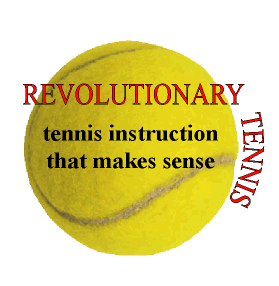
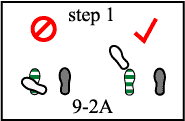 Pick up your feet. Get that back foot to move first and forward into the ball, 9-2A. It's difficult at first, but this is the first stage to a strong backhand.
Pick up your feet. Get that back foot to move first and forward into the ball, 9-2A. It's difficult at first, but this is the first stage to a strong backhand.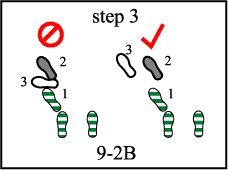 Keep the feet moving both into the ball and complementarily. You can move the feet complementarily but if not forward and into the ball the stroke/contact spot has no power due to lack of support from the body. Make sure step #3 is a step past #2 and doesn't turn and do a merengue step into the front foot, 9-2B. The Merengue!
Keep the feet moving both into the ball and complementarily. You can move the feet complementarily but if not forward and into the ball the stroke/contact spot has no power due to lack of support from the body. Make sure step #3 is a step past #2 and doesn't turn and do a merengue step into the front foot, 9-2B. The Merengue!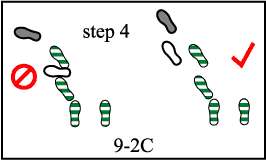 Your last step needs to be at and forward and into the ball, not off to the side where you'll wind up with your feet spread apart (and sideways), 9-2C. You never spread them out like this on a forehand, unless you do what the establishment calls a "closed stance," which is sideways, a no-no, hence the development of the open stance.
Your last step needs to be at and forward and into the ball, not off to the side where you'll wind up with your feet spread apart (and sideways), 9-2C. You never spread them out like this on a forehand, unless you do what the establishment calls a "closed stance," which is sideways, a no-no, hence the development of the open stance.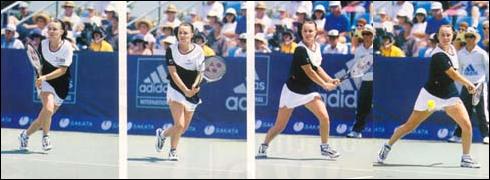
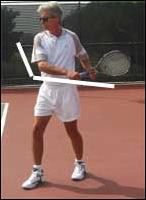 When the racket's back, notice I said "when," you should carry the racket hand waist high. This ensures your arm bends, or folds, like it's supposed to. If the ball's low or high, you still do this, one or two handers.
When the racket's back, notice I said "when," you should carry the racket hand waist high. This ensures your arm bends, or folds, like it's supposed to. If the ball's low or high, you still do this, one or two handers.